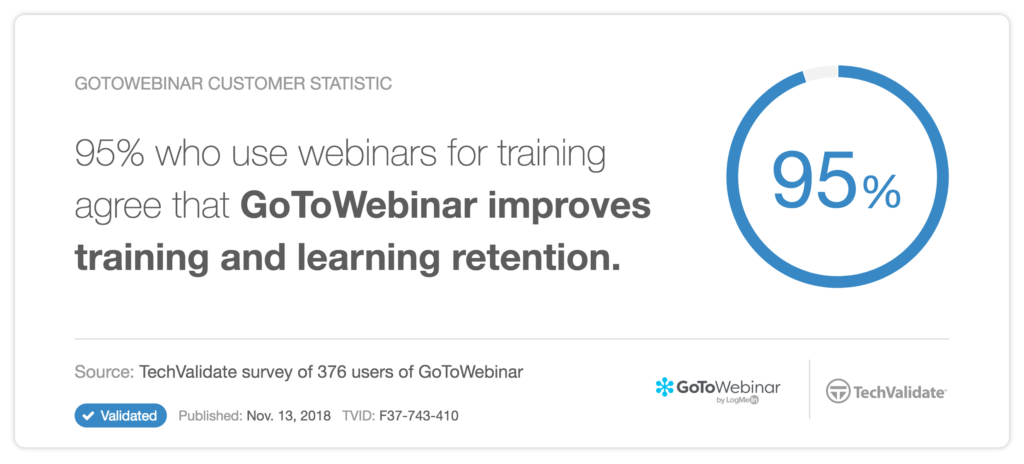Your customers are eager to use the product they just bought. You’re on the hook to deliver a great user experience and drive adoption – and to sustain sales growth, you need to do it in a repeatable way.
Get customer onboarding right and your business will reap long-lasting benefits. Get it wrong and the consequences are devasting – increased churn, low usage, and more detractors than advocates.

Webinars are a great way to onboard new customers. In fact, 95% of GoToWebinar users say webinars improve training and learning retention.
But how do you ensure your webinar captures your customers’ attention, motivates adoption and empowers them to succeed with your product?
Here are several strategies to ensure you deliver a successful customer onboarding webinar, every time.
Set the right expectations.
Prior to the start of your webinar, let your customers know:
- What you will cover during the webinar
- What they need to do before the webinar (download an app, create an account, etc.)
- And the goal and outcomes of the webinar
Getting this information to your customers prior to the webinar sets the right tone and helps them get the most out of onboarding and ultimately the product.
Pro tip: Keep in mind that adults learn differently than children. Adults are often self-motivated and can direct themselves in the learning process. This means they may prefer to read or watch videos before getting started, while others prefer to get started first and ask questions later.
Let your customers know how they can get started learning the product in a way that suits their learning style. For example, you may send them an on-demand version of your onboarding webinar and then invite them to a live Q&A session or an advanced training course.
Show your product’s use cases.
Customers learn best through examples. When you run through your product’s use cases, it inspires adoption and drastically increases customers’ understanding of when and how to use it.
Consequently, you’ve planted the seeds for success because customers will use your product in the appropriate scenarios. This leads to that “Ah-ha!” moment when they can picture themselves using your product to make their job easier.
Pro tip: If your product has unique use cases that don’t apply to all customers, consider breaking out your onboarding webinars by use case. This way the webinar is more relevant to each customer and you can take your time going over a particular use case.
Clearly demonstrate the features.
Give customers an up-close and personal walkthrough of the features right in your webinar. Take advantage of your webinar’s screen sharing capabilities and drawing tools which add a layer of interactivity and engagement. Demo the features and cover all necessary details.
Once you covered a feature or set of features, present recap slides that summarize the steps you just went through. This is vital whether your product is simple or loaded with complex capabilities.
Pro tip: When explaining features, tie them to benefits – explain why customers should care. Customers are more likely to remember something when it’s associated with a benefit.
Encourage questions.
To make sure your audience doesn’t zone out, use polls, chat, and take questions at various points throughout the webinar. Onboarding webinars should feel like interactive classes versus one-way presentations.
Also, don’t forget to be friendly and show-off your personality to build rapport and create a personal connection. A little bit of humor and chit-chat goes a long way.
Here are some ideas on driving onboarding webinar engagement:
- Poll your audience in the beginning to gauge use case and experience levels
- Encourage use of Q&A to type any question, at any time
- Pause to address questions before moving on to a new section
- Use polls at the end to get feedback on the content
- Keep it short – your webinar should be less than 1 hour. If you need to, break your webinar into a series, like a Basics and Advanced Training
Taking questions at the end is key, as it ensures that any customer gets a last chance to clear up anything they missed during the presentation.
Pro tip: Keep the conversation going after the webinar ends to really drive adoption. Make sure customers know who they can contact for additional help, where they can send feedback, and what follow-up communication they should expect from you in the future.
Supply plenty of resources.
Don’t leave your customers with a lack of self-serve resources after your webinar ends. This can quickly lead to customers, who were initially satisfied with your onboarding, failing to successfully adopt the product.
To remedy this:
- Make your webinar available on-demand so attendees can refer to it long after it’s over
- Give customers Handouts like a features guide, best practices, and video instructions that they can refer back to at their own leisure for post-webinar study
- Encourage customers to subscribe to your community, and let them know how to interact with your support chatbot, search your knowledge base.
- Inform customers of upcoming webinars
Pro tip: Webinars are a great way to onboard similar customers at once, but you should also give customers the option to meet one-on-one after the webinar. This maximizes your one-on-one time with them since they’re already familiar with the basics and allows you to go deeper into their use case. This furthers the relationship, guarantees product self-sufficiency, and leads to greater satisfaction.
Measure success.
The best and easiest way to measure your onboarding webinar’s success is to ask your customers directly. Send a survey after the webinar and ask customers how they liked the content and what you can do to improve. This is also a great opportunity to find out of they have additional questions or feedback that you can follow-up with.
Pro tip: If you want to go a step further, look at other metrics like attentiveness to see when customers were most engaged with your presentation and where they tend to drop off. Use this data to hone your content and add in more opportunities for interaction.
The importance of good onboarding.
New customer onboarding is your chance to make a great first impression. With these tried, tested and true webinar strategies, you’ll onboard your customers successfully and at scale.
